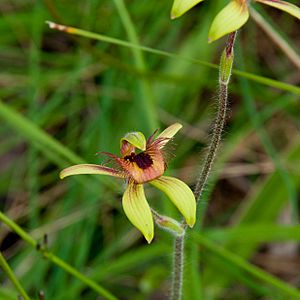Caladenia discoidea facts for kids
Quick facts for kids Caladenia discoidea |
|
|---|---|
 |
|
| Caladenia discoidea growing near Bertram | |
| Scientific classification | |
| Genus: |
Caladenia
|
| Species: |
discoidea
|
The dancing spider orchid (also called the antelope orchid or bee orchid) is a special type of orchid. Its scientific name is Caladenia discoidea. This beautiful flower grows only in the south-west part of Western Australia. It's easy to spot because its flowers grow sideways. Also, its sepals and petals are quite short.
What Does It Look Like?
The dancing spider orchid has just one leaf. This leaf is about 8 to 18 millimeters (0.3 to 0.7 inches) long. It is also about 8 millimeters (0.3 inches) wide. Both sides of the leaf are hairy.
The flower stem can be anywhere from 90 to 450 millimeters (3.5 to 17.7 inches) tall. Each stem usually holds 1 to 4 flowers. Each flower is about 20 to 30 millimeters (0.8 to 1.2 inches) long and wide.
These flowers grow horizontally, meaning they face sideways. They are yellow and green with red stripes. The petals and sepals (which look like small leaves around the flower) are very short. The flower also has a rounded, fringed labellum. The labellum is a special lip-like part of the orchid. It has dark bumps called calli on it. You can see these unique flowers from August to early October.
How It Got Its Name
The Caladenia discoidea was first officially described in 1840. A scientist named John Lindley gave it its name. He wrote about it in a book called A Sketch of the Vegetation of the Swan River Colony.
The second part of its name, discoidea, comes from a Latin word. This word means "rounded blade and thickened edge." This name was chosen because of the rounded shape of the orchid's labellum.
Where It Grows
The dancing spider orchid is found in many dry areas of south-west Western Australia. It grows between Kalbarri and Israelite Bay. You can often find it growing in woodlands. Sometimes, it even grows near the edges of salt lakes.
This orchid lives in several different natural areas. These include the Avon Wheatbelt, Esperance Plains, and Geraldton Sandplains. It also grows in the Jarrah Forest, Mallee, and Swan Coastal Plain regions.
Is It Protected?
The Government of Western Australia's Department of Parks and Wildlife says the Caladenia discoidea is "not threatened." This means it is not currently in danger of disappearing.

